K. Lang-Slattery's Blog, page 6
June 19, 2020
Metadata and Data – What, Why, and Where
Have you ever wondered, what exactly is Metadata? And why do you keep hearing this term?
“Metadata is a set of data that describes and gives information about other data” – Google dictionary
” ‘Metadata is data that provides information about other data.’ In other words, it is ‘data about data.’” – Wikipedia
I know I’m not a techy. If I were maybe this would make sense to me. But I’m sorry, these definitions seem too much like the kind of definitions my 7th grade English students used to turn in. You know, “a chicken is a bird.” Way too simplistic. Though like this chicken definition, it does get you started.
I kept reading in author advice articles that metadata about my books is important. But this “data about data” definition left me confused. I still needed to understand why its important, how to use it, where to get it, where to put it, and exactly (with examples) what it is.
My first question was, “What is the purpose of metadata?” According to Wikipedia, metadata “helps users find relevant information and discover resources. . . . For example, a digital image may include metadata that describes how large the picture is, the color depth, the image resolution, when the image was created, the shutter speed, and other data. A text document’s metadata may contain information about how long the document is, who the author is, when the document was written, and a short summary of the document.”
This was much better. Not only does it give the why, it shows examples of specific metadata.
My next question was “how do I create metadata specific to my books?” It turns out that simply put, basic metadata for a book is any data that describes or classifies your work — title, sub-title, ISBN number, publisher, author name — in short, anything a reader might use to look up your book. But it can be more too. . . things like keywords, your author bio, the book description, review excerpts, number of pages, price, publication date, and its category in the BISAC subject heading list (an industry-approved list of subject descriptors).
Here is the basic metadata for Wherever the Road Leads.
Subtitle – A Memoir of Love, Travel, and a Van
Author – K. Lang-Slattery
Publisher – Pacific Bookworks
Publication date – July 26, 2020 – e-book/January 20, 2021 – paper and hard back (tentative)*
Launch party – January 23, 2021 (tentative)*
Print ISBNs – paperback – 978-1-7342796-4-1, hardcover – 978-1-7342796-3-4,
E-book ISBNs – Kindle/MOBI – 978-1-7342796-5-8, E-pub – 978-1-7342796-6-5
Number of pages – 348
Format – 6” X 9” Hardback, (5.5” X 8.5” Paperback?)
Number of illustrations – 14
Number of photos – 13
Number of maps – 7
Category: Travel Memoir
Retail Price: 15.95 (tentative)
Wholesale distribution: IngramSparks.com
Retail sales online: Amazon.com & Smashwords.com
Ok. Now where do I put all this lovely metadata so it will actually help potential readers find my book? That turns out to be a long list of places that keep records of published books. These are the ones I use:

Bowker – the world’s leading provider of bibliographic information, connecting publishers, authors, and booksellers with readers and the ONLY official source of ISBNs in the United States.
Library of Congress – Research library and de facto national library of the United States.
Amazon –Author pages and book sale pages both display book and author information.
Bookbub – a service that helps readers discover books and provides publishers and authors with marketing tools and strategies to help sell more books
Smashwords – a distributor of indie e-books
Book printers/Print on Demand – for me that’s IngramSparks and Kindle Direct Publishing.
Goodreads – site for readers and book recommendations.
One of the most helpful hints I found was advice to keep the metadata consistent. To make this easier, I created a METADATA file for each of my books. These files list all the important statistics, bios of various lengths, the cover image, keywords, and anything else that might be important or requested by one of the above platforms. With these files set up, all I have to do is copy and paste and . . . Voila! The wording and the data are the same everywhere.
I am now a metadata whiz. I hope this brief explanation helps you understand this techy term. And I hope my use of metadata will help new readers find my memoir, my novel, and the Caitlin books too.
* Publication and launch dates for my memoir are tentative. We are considering the staggered dates because of Covid19 conditions. My thinking is to get the e-book out as soon as possible because e-books sales are booming while people are stuck at home. The paperback & hardcover can be set up for pre-orders with a full release in January, after all the confusion and media blitz that will accompany the upcoming national election. If you want to give Wherever the Road Leads as a holiday gift, let me know and I will see what is possible. Perhaps an “artistic” gift certificate for an autographed copy will work. Then, with more publicity after the new year, I would do a launch in late January. If an in-person launch party remains impossible, I will try for a virtual launch — a kind of Zoom party. Your thoughts on this plan would be appreciated.
The post Metadata and Data – What, Why, and Where appeared first on Klang Slattery.
June 4, 2020
A Book Cover for Wherever the Road Leads
Efforts to design the perfect book cover for Wherever the Road Leads have been grueling. So many decisions! So many great ideas! Thank you to my wonderful team of advisors.
Recently, I posted blogs about selecting the photos and the pen and ink illustrations for my memoir. The process of choosing from an existing group of possibilities was much easier than creating a book cover. With a good designer there are infinite possibilities and variations. Ideas flow, but in the end I had to make the final choice.
A book’s cover fulfills many functions. It must represent the book’s story at a glance so a potential reader knows what to expect inside. The front cover should entice that reader to turn the book over and read the blurbs or reviews on the back or read the end-flaps of the paper jacket. A front cover design uses an image (or a collage of images) and displays the title (and the sub-title, if there is one) and the author’s name. Sometimes it also has a short excerpt from a review or a note such as “By the best-selling author of ………….”
Contemporary book covers tend to use simple images and very large fonts. The title, or if the author is famous the writer’s name, often dominates. A simple picture behind a huge font is easier to read in the thumbnail size used by on-line book retailers such as Amazon, BookBub, or Barnes and Noble.
Knowing these basic requirements my designer, Cole, and I set to work. In the beginning, I probably gave him too much input, including that I wanted to use my art work. I sent him a broad selection of my drawings, a watercolor, and a few of Tom’s photographic images I thought might work. Based on the title Wherever the Road Leads, we wanted to show a road and a van.
Several of my friends and a beta-reader had commented that the van is an important character in my memoir. But the image couldn’t be just any VW van—I insisted it be our green van, correct in every detail. Unfortunately, few of the photographs Tom took showed the van to advantage. “The Turtle” was either in dark shadow, hidden by trees and bushes, or out of focus. As a result, I began to make pen and ink drawings of the van. We hoped to photoshop these drawings into some of the pen and inks done on the trip. I scanned the black and white van drawings into Adobe Photoshop, then colored them using watercolor or colored pencil and scanned them again. Some needed refining or further clean up further. In the interest of accuracy, I created four versions— each showing a different side of the van with either a front or a rear aspect. I also drew separate versions showing the bundles we carried on the roof for the first year and the van with the roof-box Tom built for our overland trip to India. I am now totally over ever doing another drawing of our beloved green Turtle! 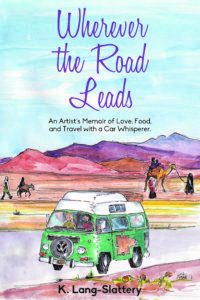
Cole created composite images setting the van into earlier 1972 landscapes and two new background images I created. Turning these into covers necessitated looking at fonts. My first choices were script fonts as these suggest a handwritten journal. However, script fonts proved difficult to make really bold and were often difficult to read.
After Cole created several cover designs we both liked (two in color and two in black and white), I sent them out in a poll to my beta-readers and some of my long-time friends familiar with our travel adventure. The results came back with two, strong winners, both in color.
However, one of the people polled, a free-lance editor who I have corresponded with over the years, commented that all the samples had a retro feel. She added that this might be OK as my story takes place in the 1970s but that I probably didn’t want prospective readers to bypass the memoir because it “looke d like an old book.” She recommended that Cole and I study more modern
d like an old book.” She recommended that Cole and I study more modern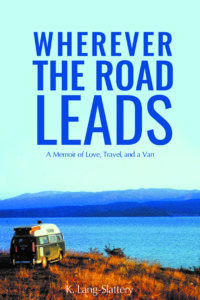 covers; a suggestion I took seriously.
covers; a suggestion I took seriously.
I also wanted to see what Cole might create with fewer suggestions from me. I wanted to let his design talents fly. When he sent me the next set of samples, this time using stock images rather than my art work, I was prepared not to like them. But surprise! I loved what he had done. Further work with the images and with some of Tom’s photos we hadn’t considered before resulted in more contemporary cover designs. I sent out three of the new designs with the top two from the first round. The results were clear—the strongest contender remained one of the “retro” covers but with a more contemporary font arrangement.
I was definitely time for me to make a choice!
Here is the design that will be used as the cover for Wherever the Road Leads.
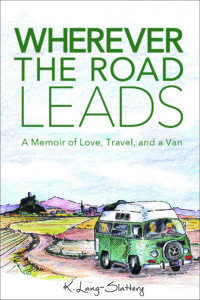
Now Lorie DeWorken, my interior designer, can proceed with the interior design, a subject for another post.
Lorie DeWorken, book designer. www.mindthemargins.com https://pubpronetwork.org/provider/mind-the-margins-llc/
Cole Waidley, graphic designer of logos, book covers, pamphlets, and clothing. https://www.linkedin.com/in/colewaidley
http://www.creativeshake.com/zoom.html?User_number=cwaidley&imagecount=2
The post A Book Cover for Wherever the Road Leads appeared first on Klang Slattery.
May 25, 2020
Paris Memoirs of Art and Love
Art and Paris memories flow from A Paris Year, by Janice MacLeod. I found this book just as the Covid-19 pandemic nudged into our consciousness. Days later, I regretfully cancelled a planned “April in Paris/Tulip season in the Netherlands” trip. Instead of walking the streets of Paris myself, I read Janice’s book, a delightful guide to the vicarious delights of France’s most famous city.
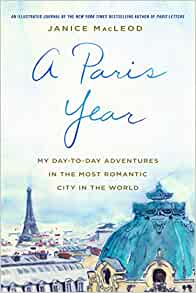 Too small to be a “coffee-table book,” A Paris Year is definitely gorgeous enough to be one. Printed on luxurious paper, the pages display MacLeod’s musings, photos, drawings and watercolors from her year living in the City of Light. The author shares her relaxed wanderings as she drinks thick, rich hot chocolate at a café table, collects old postcards at the flea market, snaps photos of art work and creepy gargoyles, and hints at her attraction to the neighborhood butcher. Designed to resemble an artist’s journal with a font that evokes hand written notes, the pages are dotted with coffee spills and the circular imprints of wine glasses. A Year in Paris is a book to inspire the artist an
Too small to be a “coffee-table book,” A Paris Year is definitely gorgeous enough to be one. Printed on luxurious paper, the pages display MacLeod’s musings, photos, drawings and watercolors from her year living in the City of Light. The author shares her relaxed wanderings as she drinks thick, rich hot chocolate at a café table, collects old postcards at the flea market, snaps photos of art work and creepy gargoyles, and hints at her attraction to the neighborhood butcher. Designed to resemble an artist’s journal with a font that evokes hand written notes, the pages are dotted with coffee spills and the circular imprints of wine glasses. A Year in Paris is a book to inspire the artist an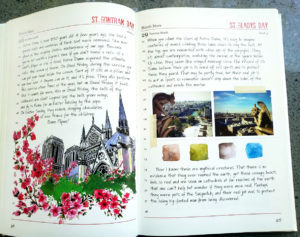 d the traveler in you. I especially loved the occasional samples of watercolor hues found next to photos. These little rows of color squares hint at paintings waiting to be created.
d the traveler in you. I especially loved the occasional samples of watercolor hues found next to photos. These little rows of color squares hint at paintings waiting to be created.
My pleasure in this lovely work, drew me to the author’s previous book, Paris Letters, One Woman’s Journey from the Fast Lane to a Slow Stroll in Paris. This memoir, a prelude to A Year in Paris, is a joy. Janice begins her story in Los Angeles, where she is a well-paid upper-level advertising copy writer and editor. Unhappy with the clutter and stress of her life, Janice wonders how much money she would need to save to take off for a year of travel. Speculating that $100 a day might be enough if she were frugal (this was in 2010), MacLeod develops a plan for saving, spending less, and simplifying her life. “My first step to Paris started in my underwear drawer,” she writes. A year later her adventure begins with six-weeks in an apartment on rue Mouffetard in Paris.
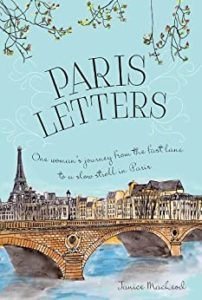 MacLeod’s writing is relaxed, honest, and lightly humorous. To save for you the delight of discovery, I can only disclose that the neighborhood butcher is tall, good-looking, and responsive to Janice’s smiles. Besides her intimate adventures and city rambles, MacLeod starts an Etsy business to sell subscriptions for copies of hand-painted “Letters from Paris.” The memoir ends delightfully with a list of 100 suggestions on how to “save or not spend $100 a day.”
MacLeod’s writing is relaxed, honest, and lightly humorous. To save for you the delight of discovery, I can only disclose that the neighborhood butcher is tall, good-looking, and responsive to Janice’s smiles. Besides her intimate adventures and city rambles, MacLeod starts an Etsy business to sell subscriptions for copies of hand-painted “Letters from Paris.” The memoir ends delightfully with a list of 100 suggestions on how to “save or not spend $100 a day.”
If you are partial to love stories, travel stories, and art, Paris Letters and A Year in Paris, two completely different renderings of the same story, will take you into a world far from the restrictions of sheltering at home. Both books rate five stars from me.
To see Janice MacLeod’s lovely hand-painted letters and other offerings on Etsy go to:
https://www.etsy.com/shop/JaniceMacLeodStudio
The post Paris Memoirs of Art and Love appeared first on Klang Slattery.
May 15, 2020
Illustrations for a Travel Memoir, Wherever the Road Leads.
Wherever the Road Leads has always been planned as an illustrated memoir. After all, with a subtitle that starts “An Artist’s Memoir . . .,” readers will expect to see artwork. Luckily, I didn’t have 1000 drawings to choose from like I did with the photos. However, because of page consideration (Print on Demand services charge by the finished number of pages), I still must be selective.
I was able to place some of my smaller sketches, including a few that were scrawled in the margins of my letters home, and a couple of my horizontal drawings, into the route maps that will separate sections of the finished book. That still left me with more drawings than I could use. Again, with the help of input from my readers, my editor, and a few long-time friends, I made the difficult selection.
I tried to choose drawings to represent different phases of our travels. However, extra busy days and long drives often inhibited my motivation to sit down and draw. The drive overland to India and the hectic days on the bumpy roads there were an especially difficult environment for drawing. Besides, my fascination with the colorful local ways of dressing let to studies of clothing, rather than the pen and ink landscapes I had previously done.
Some of the illustrations are quick sketches, usually done from my own photos or outside on location, en plein air. Others are more detailed pen and ink drawings, tighter, with more strokes and shading. These were often done using printed tourist postcards as inspiration. The high cost and long wait times to get film developed overseas in the 1970s (pre-24-hour service and digital photography), often made it impossible for me use photos I had taken myself. I think you will easily see the difference between the two styles of drawing.
I hope you will enjoy a few of the drawings below that I have selected to illustrate Wherever the Road Leads. I’ve included one of the illustrated route maps too. I’d love to see comments in the form below this post.
Which drawing is your favorite?

Sketch of San Miguel de Allende
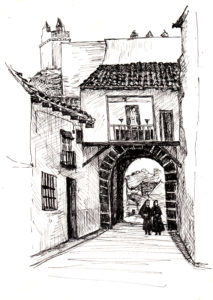
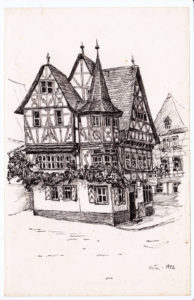
Spanish Street The Rhine River Valley. .
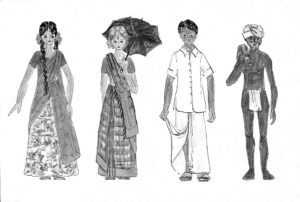
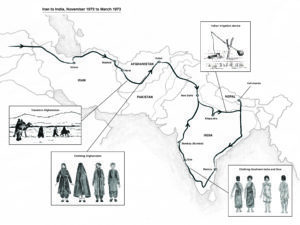
Costume study, southern India
The post Illustrations for a Travel Memoir, Wherever the Road Leads. appeared first on Klang Slattery.
May 3, 2020
Photos for a Travel Memoir
Selecting the illustrations for Wherever the Road Leads has sent me down memory lane yet again. I plan for the book to have three kinds of illustrations:
• Photos taken by Tom of our travels
• Pen-and-ink drawings I did along the way
• Route maps with small sketches to show where we went
I concentrated on the photos first. Several months ago, I went through all the slides (I’d estimate almost 1,000) Tom and I took over the two years we traveled in the van. It was interesting to see that, in the beginning, we didn’t do much photography. Maybe we were too worried about car troubles during the first several months of our adventure. However, as the time rolled by, Tom took more and more pictures. By the time we got to India, he was adept at using his two lenses, especially the telescopic.
Somehow I was able to narrow the slices down by half. Next I then sent the best 500 slides to Costco to be digitalized and stored on a CD as well as on Google photos. Another pass through the pictures, with my daughter’s help, enabled me to narrow the selection to about 25 I thought could make good book illustrations.
Because of the prohibitive cost of printing the interior with any color, all the photos had to be converted into black and white. My wonderful graphic artist, Cole Waidley, accomplished this easily. He also sharpened their focus as much as possible and I cropped a few of the images to improve their composition. Now we were ready for the next step.
I sent a selection of the best photos to my beta-readers, my editor, and a few friends who have heard segments of the story over many years of friendship. The input I received helped me select the 13 photo illustrations that will appear in Wherever the Road Leads.
Here are a few I thought you might enjoy now. Which is your favorite? Do you think these photos help tell the story?
Tom and me at our wedding. Washing laundry in a river while village children watch.
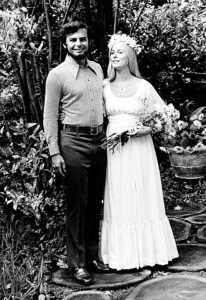
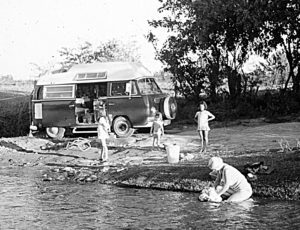
I loved shopping for spices at the Moroccan Souk. My nephew and niece enjoy smoked eel with me.
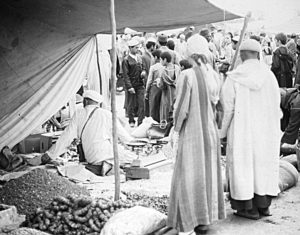
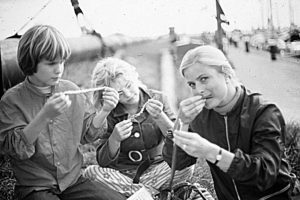
Tom and I enjoy a lunch of boiled shrimp in Norway. Main street in Herat, Afghanistan.
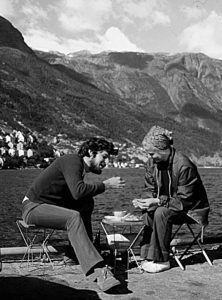
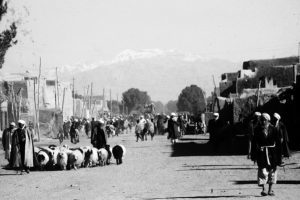
The post Photos for a Travel Memoir appeared first on Klang Slattery.
April 24, 2020
Travel as Education (after the Pandemic)
For those of us with travel in our DNA, this is a difficult time. We are stranded in our homes with no place to go. Besides this, due to the Covid-19 pandemic, many parents have unexpectedly found themselves home alone educating their children. As they struggle with this difficult role, many parents can’t wait for schools to reopen. They want their children back in a classroom environment.
It seems like a good time to share my belief that education outside the classroom can be just as important to expanding minds as any normal schoolroom curriculum. Subjects like science, literature, art, history, civics, anthropology, and geography are easily pursued at home with the aid of the internet and books. Paradoxically, the current stay-at-home orders remind me of the value of travel for children. OK, I can hear you screaming, “But we can’t travel! We have to stay at home.” Very true. Please bear with me as I unravel the mental links.
After this is over, don’t forget the ways your kids flourished at home during these restricted days. They are rediscovering books (literature)? Cooking side by side with family members (nutrition and science)? Coloring thank-you notes for nurses and doctors (art and service)? Have they taken up sewing protective face masks for the homeless (practical skills and social responsibility)? Are they Googling? Streaming documentaries? Learning to dance? Searching for answers on the internet? This hands-on style of learning is not unlike the way travel can expand a child’s understanding of the world. So, when we return to “normal,” when we are back at work and our children are back in the classroom, I urge parents to be unafraid. When life opens up again, try travel with your children to expand their world view.
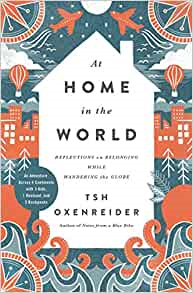 In her memoir, At Home in the World, Tsh Oxenreider declares in her preface, “I can shout from the rooftops that you can both love to travel and be happily married with children . . . Parenting and global travel—I can’t think of a better mix.” Tsh tells of the ups and downs of her family’s extended journey through details, conversation, specific travel experiences, and humor. It is clear by the end of this delightful memoir that her children have grown and matured during their international adventure. They have learned more about the world and about themselves than they ever could in a traditional classroom.
In her memoir, At Home in the World, Tsh Oxenreider declares in her preface, “I can shout from the rooftops that you can both love to travel and be happily married with children . . . Parenting and global travel—I can’t think of a better mix.” Tsh tells of the ups and downs of her family’s extended journey through details, conversation, specific travel experiences, and humor. It is clear by the end of this delightful memoir that her children have grown and matured during their international adventure. They have learned more about the world and about themselves than they ever could in a traditional classroom.
Now don’t get me wrong, I am an ex-teacher myself and I value classroom education. Essential for learning the basics of reading, math, science, history, and socialization, traditional education, at its best, coordinates facts and perfects skills. However, the experiences of travel can take children a step further. I’m not talking here about skiing and beach vacations at a resort, though these can be fun and relaxing. What I want to encourage parents to try with their children is the art of serious travel and discovery. Anything from a week at a national park exploring nature to a year traveling Europe in a van—there is no better way to help children connect with the world around them and develop critical thinking skills. In the long term, a few weeks lost from the regular school year won’t be missed and benefits will far surpass your expectations.
My experiences traveling with children —from two summer months traveling in a van around Great Britain and the Netherlands with  my school-aged niece and nephew (see photo to left of Mike, Michelle, and myself eating smoked eel in The Netherlands, from my memoir, Wherever the Road Leads), to a winter month in New Zealand with our 18-month-old son and nine-year-
my school-aged niece and nephew (see photo to left of Mike, Michelle, and myself eating smoked eel in The Netherlands, from my memoir, Wherever the Road Leads), to a winter month in New Zealand with our 18-month-old son and nine-year-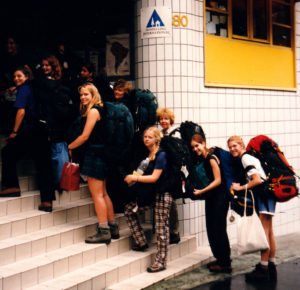 old daughter in tow, to six-weeks backpacking Europe with a group of teen-aged Girl Scouts (photo right)—I am convinced that travel is a gift worth sharing. I challenge you to offer the experience if you haven’t already. You will be amazed to see what happens.
old daughter in tow, to six-weeks backpacking Europe with a group of teen-aged Girl Scouts (photo right)—I am convinced that travel is a gift worth sharing. I challenge you to offer the experience if you haven’t already. You will be amazed to see what happens.
A few suggestions:
• Encourage the kids to help plan activities and places to go.
• Allow time between intense travel for relaxing.
• Make contact with local families and/or spend time at playgrounds.
• Encourage reading about the area you are visiting and limit access to TV and smart phones.
• Have the kids keep a journal or write postcards to themselves to mail home.
• Teach basic travel skills (how to use the metro, map/GPS reading, packing, safety in crowds, etc.)
• Don’t limit yourself to school vacations when lines can be frustrating. Besides, going during the school year will make your kids feel special.
In addition, two very important parenting suggestions:
• Know your children’s interests and responsiveness to different types of experiences. My son, an adventurous traveler as an adult, was an enigma in his youth. As a seven-year-old, he earned the nickname of “The Sponge” due to his insatiable interest in American history during a summer visiting Williamsburg, Plymouth, Boston, Washington, DC. and New York City, where he (unbelievably) fell in love with Tiffany stained glass at the Metropolitan museum. Three years later on a trip to Hawaii, he was decent company only at the beach or when we flew in a helicopter over a bubbling volcano. He was little more than an ill-tempered slug at cultural activities 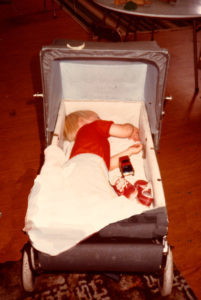 (luaus and museums).
(luaus and museums).
• Allow some time for adult decompression, even if this means Father and Mother take turns or utilize local day-care opportunities. I’ll never forget the lovely sight of my toddler son sound asleep in an old-fashioned pram (photo on right) when we returned to pick him up from the municipal infant day care (known as a crèche) in Christchurch, New Zealand. Even better was the gourmet dinner I had enjoyed without a nursing child in my lap.
Here is an interesting article about planning travel after Covid-19: https://www.washingtonpost.com/travel/tips/how-plan-your-first-post-pandemic-trip/?m_campaign=wp_by_the_way&utm_medium=email&utm_source=newsletter&wpisrc=nl_bytheway
What is your “travel with children” experience? Do you have any important tips to share?
amazon.com/author/langslattery
The post Travel as Education (after the Pandemic) appeared first on Klang Slattery.
April 19, 2020
Comfort Food for Shelter in Place Days
The simple cooking style I practiced of necessity in my van-life days translates well to the shelter in place weeks we are experiencing now. One of my favorite comfort food ingredients, white sauce, is finding its way back into my repertoire.
If you are older (say in your 70s like myself), mid-twentieth century comfort food may be calling to you in these stressful times. For all of us, comfort foods are the dishes that remind us of the love and safety of our childhood home. In the decades between 1940 and 1970, many traditional family meals originated in the great depression when food was sometimes scarce and money scarcer. Our mothers (or grandmothers) learned to be frugal and prepare meals that satisfied the stomach without leaving a hole in their pocketbooks. Many of these simple comfort foods used dairy products—think Macaroni and Cheese, custard, Tuna Noodle Casserole, bread pudding, and those great layered Stratas made of little more than stale bread, eggs, cheese, and milk.
When I was a child, canned goods were plentiful but frozen food was a modern luxury few could afford or store. Refrigerators were small and if they had a freezer, it was inside the main compartment and only big enough to hold an aluminum ice-cube tray and a rectangular pint of ice-cream. Home cooks knew how to use pantry items and staples that needed little or no refrigeration. If you were lucky your family might have a shelf in the basement stocked with home canned vegetables, fruits and jams.
My mother understood the value of calcium to growing children. I remember she used to say that Americans were taller than Europeans and Asians because we drank more milk. True or not, that was my mother’s interpretation and she made sure we had some kind of dairy at every meal. With limited refrigerator space, fresh milk was reserved for drinking and breakfast cereal. For cooking, where the clean flavor of fresh milk was not essential, she often used dry powdered milk or canned evaporated milk. Today, we also have long-shelf-life milk, a super pasteurized product that keeps close to three times longer than “fresh” milk.
In these pandemic days, I have cut back on trips to the grocery store. When I do go, I find myself looking at things that safely store longer making frequent trips to the grocery aisles unnecessary. Sometimes the dairy and freezer sections stand half empty and selection is limited. I find myself returning to staples I used during the two years I cooked in a Volkswagen van (as told in my upcoming memoir, Wherever the Road Leads) —dried or canned milk, canned fish and vegetables, pasta, rice and beans.
I have to admit, that many of my favorite comfort foods start with a good Bechamel sauce. My mother called it White Sauce and declared it too much trouble, though I suspect she avoided it because of its high calorie content. I learned to make creamy, lump free, white sauce in my high school home economics classroom. Mrs. Messman taught us that white sauce wasn’t difficult as long as you kept stirring and didn’t let those pesky lumps form in the bubbling milk.
Bechamel sauce can be made using fresh, extended-life, reconstituted dried, or canned evaporated milk. Besides the milk, all you need is butter (or some other fat or oil), a little flour, salt and pepper. A heavy bottomed pot helps prevent scorching the milk and a wooden spoon or a wire whip is needed for constant, patient stirring. Recipes for classic Bechamel sauce (aka cream sauce or white sauce) abound in basic cookbooks like The Joy of Cooking or Better Homes and Gardens New Cookbook, as well as on the internet.
The sauce can be made ahead and stored in the refrigerator for about a week to be used as needed to create a rich and delectable dish from all kinds of left overs or pantry staples. Some classic dishes that use white sauce are: Seafood a la King, Kedgeree (a casserole of rice and canned fish), filled dinner crepes, Croquettes, Tuna Noodle Casserole, New England Clam Chowder (or any creamed soup), and the ubiquitous Macaroni and Cheese.
In my tiny, van kitchen (two burners, no oven, and a bar ‘fridge) one of the white sauce dishes I prepared regularly was Creamed Tuna on Toast. Not very elegant, certainly not something my mother would have served, it was satisfying after a long day on the road and easy to make when we hadn’t been to a market recently. If I had canned tuna, dried or canned milk, and bread on hand, dinner could be ready in minutes. I would prepare the sauce, stir in the tuna along with any left-over or canned veggies I could scrounge up to make it healthy, and pour the mixture over sliced bread browned (in the absence of a toaster) in a skillet. Garnished with some chopped parsley, a few olives, or  a slice of tomato, it even looked pretty on the plate.
a slice of tomato, it even looked pretty on the plate.
Though I haven’t made creamed tuna for almost fifty years (not since our return from the long van-life adventure), I’ve been thinking a lot about those meals recently. Maybe it’s time to make it again.
What comfort food do you find yourself craving these days? Have you made any long neglected, mid-twentieth century dishes recently?
The post Comfort Food for Shelter in Place Days appeared first on Klang Slattery.
April 4, 2020
Nomadland, A Book about Van-life Today
Over the last months, while I was researching travel memoirs, I came across Nomandland, by Jessica Bruder. Not a memoir, still this triumph of personal journalism hit a cord with me because it reveals van-life as it is today.
I am aware of the trend of adventurous youth to spend some years living in a van or camper on the road. Some time ago, I read about the upswing of interest in van living that highlighted in The New Yorker Magazine (“#Vanlife, The Bohemian Social-Media Movement,” April 2017 issue). Instagram reveals dozens of hashtags about this lifestyle, including #vanlife (266,126 posts), #vanlifediaries, and #vanlifeexplorers.
Jessica Bruder’s brilliant and fascinating book explores a different aspect of life on the road. The author interviews, intimately gets to know, and becomes friends with men and women who turn to the nomadic life-style for serious financial reasons. She makes clear in the very beginning that these travelers are not homeless. They have shelter and transportation. The nomads of the American 21st century prefer the label “houseless.”
It was the aspect of living in a van (or a camper, truck, or sedan) that first caught my interest. I could identify with many of the issues confronted on a daily basis by the people the author meets and introduces to readers. The real people of Nomandland deal with issues of space, storage, hygiene, power, car repairs, and how to find a safe place to park for the night. These are the same concerns Tom and I dealt with during two years living in a Volkswagen minivan in the early 1970s.
I especially enjoyed the details that reminded me of those years. How do today’s van-dwellers wash clothing and hang it to dry? I had to nod in understanding when I read of damp laundry strung across the inside of the vehicle. How do they handle hygiene and water supply? Gyms and truck stop showers. And what about that all-important safe sleeping spot? Modern day vanners in the US look for Wal-mart parking lots, undeveloped public lands, and side streets in commercial areas. These are the places they hunker down after dark, pull the curtains closed, and turn off the lights. They sleep, often knowing they must be up and out in the early morning hours.
For modern van dwellers, entertainment consists mainly of the internet, socialization at camp areas, and reading, including the constant sharing of books. Jessica Bruder writes that Travels With Charley, “John Steinbeck’s tale of road-tripping in a pickup camper . . . [in the 1960s] was popular among the nomads and dog-eared copies passed from hand to hand.” Steinbeck’s memoir was one of our (Tom and I) main inspirations to travel by VW camper-van. I love that Steinbeck’s writing still helped travelers.
Today’s “houseless” enjoy a few advantages that Steinbeck, Tom, and I did not: internet and cell phones to stay in touch with family, solar panels on their roofs to bring in more electricity, the ease of finding a truck stop with hot showers or a local laundromat. Still, I’m sure they would gladly trade these conveniences for the financial security Tom and I possessed.
The emotional stress felt by financially struggling nomads today is very different from the bliss of my van-life years. They don’t have savings waiting for them at home or a strong union to help find a well-paying job at the end of the adventure. Twenty-first century nomads see no end to their lifestyle. They work long, physically taxing hours doing seasonal work at Amazon warehouses, in agricultural fields, and as camp hosts at public campgrounds. Most are of social security age and they worry about their health and how they will manage in ten years.
Besides the descriptions of van living, Bruder’s book covers in depth the social issues of our time that have sent so many people on the road, living from paycheck to paycheck, and ending each day sleeping in their vehicles. Nomadland is an important read for anyone concerned with our growing numbers of poor—both the homeless and the houseless.
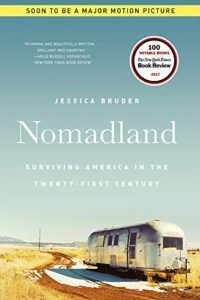 To quote the back-cover blurb: “Nomadland tells a revelatory tale of the dark underbelly of the American economy—one which foreshadows the precarious future that may await many more of us.”
To quote the back-cover blurb: “Nomadland tells a revelatory tale of the dark underbelly of the American economy—one which foreshadows the precarious future that may await many more of us.”
I highly recommend Nomadland, Surviving America in the Twenty-First Century, by Jessica Bruder, 2017, W.W. Norton & Company.
The post Nomadland, A Book about Van-life Today appeared first on Klang Slattery.
March 21, 2020
Mexican Fried Rice, Van-life Cooking at a Time of Uncertainty
Last night for supper I prepared a rice dish that was inspired by both Chinese Fried Rice and the delicious Persian dish, Baghali Polo.
Creating new dishes has always been relaxing and fun for me and, during these days of enforced “sheltering in place,” I’ve set myself the goal of making the best use of what food I already have in the cupboard. Normally I shop for groceries several times a week, but my plan for the next month is to hunker down and use what I have in the refrigerator, freezer, and pantry. These are skills I perfected during the two-year road trip that is the subject of my upcoming memoir, Wherever the Road Leads. Often, we didn’t know when or where we would find the next grocery store or open market. Occasionally my small cupboard offered nothing more than a few cans and a bag of pasta. Other times, after a visit to a local market, I would have a surplus of food. Our mini-refrigerator could barely house fresh meat, eggs, and dairy, so produce was stored in tubs and bags on the floor of the van. There the veggies and fruit gradually aged and threatened to spoil before I could use them all.
My early cooking experiences in the van, often far from a grocery store, taught me to be creative with ingredients and use everything. I pride myself that I know what is in my refrigerator and cupboard and seldom allow anything—not even a couple tablespoons of chopped nuts or half a jalapeño—to go to waste or spoil. My “van-life” cooking skills will come in handy during these difficult times as my usually well-stocked home larder begins to empty.
Yesterday, I searched my refrigerator shelves for ingredients to create a side-dish for a portion of fresh salmon purchased at Costco earlier in the week, the last such trip I intend to indulge in for some time.
Here is what I found:
• Cooked rice left from the previous night’s Green Curry. Whenever I steam plain rice to go with an Indian or Chinese dish, I make extra. Pre-cooked rice can be stored in the refrigerator for several days and also freezes well. Best of all, cold, cooked rice is preferable for dishes like fried rice.
• a 1/4 cup of chopped cilantro (also left from the night before).
• a fresh jalapeño chili that was starting to get wrinkled.
• a half of a red-pepper, also showing a few wrinkles.
The pantry offered up an onion, garlic, a can of kidney beans, and flakes of dried chilies.
Preparation of this Mexican Fried Rice is easy. Get everything set out in bowls ahead of time and toss it all together in 5 minutes when you’re ready to eat—enough for a side dish for 2 or 3 or a vegetarian main dish for one hungry person.
Set aside in separate bowls:
• About 1/2 cup chopped onion and 3 cloves garlic, chopped
• 1 and 1/2 cups cold cooked rice and 1/2 of a 15.5 oz. can of kidney beans or black beans. Sprinkle with a pinch of chili flakes (optional).
• Salt and pepper. (plus a few sprinkles of ground cumin or even chili powder, if you like.)
• Seeded and diced red pepper (approx. 1/2 cup) and half a large jalapeño seeded and diced, more if you like it spicy.
• Up to a 1/2 cup of chopped cilantro or a combination of cilantro and chopped green onion..
Heat a couple of tablespoons of olive oil in a skillet. Sauté the chopped onion and garlic on medium heat until soft. Add the rice and beans. Stir fry for about 5 minutes on high to heat through, but don’t let it scorch. Sprinkle with spices if you want. Add chopped red peppers and jalapeño and stir fry another 3 minutes or so. Salt and pepper to taste. Add the cilantro and the green onion if you have it. Stir and toss for another minute. Turn off heat and serve.
Sorry, no photo this time as I had no idea while I was cooking that I would write this. Please let me know if you’d like to see more “Van-Life Cooking” blogs.
The post Mexican Fried Rice, Van-life Cooking at a Time of Uncertainty appeared first on Klang Slattery.
March 20, 2020
Comparable Books for A Travel Memoir
A nonfiction book (including a travel memoir such as Wherever the Road Leads) is first presented to an agent or publisher in the form of a book proposal. One of the most important elements of this proposal is the section of competitive and complementary books. These are often called “Comps.”
I looked for narratives that matched my own in some way. I scanned memoir lists for woman authors who wrote of long road trips. These are popular, though most focus on solo travel and personal discovery. I found stories of travel with a man, told from the woman’s perspective, to be a rare commodity. Travel books that talked of the local cuisine were a easier to find. Illustrated memoirs were also rare. Still, my search turned up many worthwhile books, and I developed a list of comps.
As I composed my proposal, my go-to resource was How to Write A Book Proposal by Judy Rein and Michael Larsen. This extremely helpful book, published by Writers Digest Books, included an entire chapter devoted to comps. The authors write, “A well-constructed comps section will convince publishers that you . . . can judge your book accurately . . . [and] have a verifiable new slant.”
But it was the first sentence of the next page that opened my eyes to another factor. “Effective comparisons dig a hole your book will fill.” The things that made my memoir unique were as important as the similarities to my chosen comps. With this broadened understanding I set to work.
Here it is the comps section of my book proposal:
Comparative Titles
In the opening sentence of his introduction to Inventing the Truth (2018), William Zinsser says, “This is the age of memoir.” These days, travel memoirs, longtime staples of the genre, need to be more than descriptions of places visited. However, the medley of a personal relationship story and exciting travel experiences can be a winning combination.
A couple of best-selling memoirs of this type come to mind: Eat, Pray, Love by Elizabeth Gilbert and Without Reservations by Alice Steinbach. Because of their fame, I hesitate to list them as comps, though some parallels exist between Wherever the Road Leads and these two books. All three share a love story, an interest in food, travel to India and Italy, and are told by a female narrator. In fact, during the time frame of my memoir, I was only a few years younger than Elizabeth Gilbert when she made her journey.
Two other memoirs (not quite so famous) written by women traveling alone describe journeys to some of the same places Tom and I visited. In Nothing to Declare, Memoirs of a Woman Traveling Alone (published by Houghton Mifflin in1988), author Mary Morris recounts a long stay in San Miguel de Allende, Mexico, the first major town Tom and I visited. Alden Jones writes of more contemporary travels in her collection of linked essays, The Blind Masseuse, A Traveler’s Memoir from Costa Rica to Cambodia (Terrace Books, 2013). The style and organization of this book differ quite a bit from my memoir. I was especially interested in Jones’ insights into the way travel changes the traveler, a phenomenon Tom and I certainly experienced and which I tried to show in my story. But these memoirs of solo adventure cannot show how travel changes two people and their relationship to each other, something that is integral to my story.
One of my favorite comps is An Embarrassment of Mangos: A Caribbean Interlude, by Ann Vanderhoof, published in 2004 by Broadway Books of Random House. This memoir, like Wherever the Road Leads, relates the intimat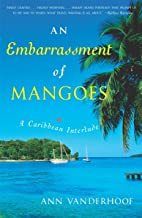 e story of a young couple traveling in a tight space (a 42-foot sailboat) for two years. In her book, Vanderhoof highlights her introduction to and experimentation with Caribbean food. An Embarrassment of Mangos is sprinkled with cooking descriptions and recipes. Though I include experiences with food and cooking in my memoir, I also share my interest in art. The inclusion of artwork done during the journey will contribute a dimension that is rare.
e story of a young couple traveling in a tight space (a 42-foot sailboat) for two years. In her book, Vanderhoof highlights her introduction to and experimentation with Caribbean food. An Embarrassment of Mangos is sprinkled with cooking descriptions and recipes. Though I include experiences with food and cooking in my memoir, I also share my interest in art. The inclusion of artwork done during the journey will contribute a dimension that is rare.
We’ll Always Have Paris, by Jennifer Coburn, published in 2014 by Sourcebooks, is a travel memoir with a mother/daughter relationship at its heart. Though the story 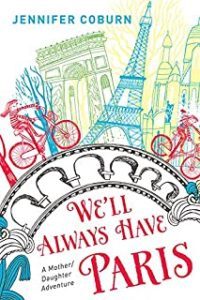 of a new marriage, Wherever the Road Leads mirrors Coburn’s honest storytelling. Like Coburn, I share my personal foibles, mistakes, and emotions through the use of detail and dialogue.
of a new marriage, Wherever the Road Leads mirrors Coburn’s honest storytelling. Like Coburn, I share my personal foibles, mistakes, and emotions through the use of detail and dialogue.
A more recent comparable memoir The Yellow Envelope, One Gift, Three Rules, and a Life-Changing Journey Around the World by Kim Dinan, was also published by Sourcebooks (2017). When Kim and her husband Brian decide to leave their homebound lives to follow her dream of world travel, they find the new lifestyle and stress of travel cause them to rethink their relationship. The nuances of the book’s premise (represented by the yellow envelope) of passing on “small acts of kindness to strangers,” is surpassed by Dinan’s story of change and growth, a theme shared by Wherever the Road Leads. Both books honestly tell of the ups and downs w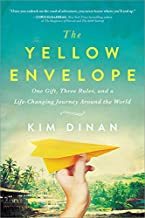 ithin a marriage. Throughout her memoir, Kim Dinan recounts her intimate thoughts, emotions, worries and concerns. My writing style in Wherever the Road Leads shows these things through dialogue and action rather than telling them through internal musings. Another big difference between the two memoirs is that Wherever the Road Leads takes place between 1971 and 1973 and includes travel to places no longer easily accessible (Afghanistan), while Kim and Brian’s story is set in a totally contemporary world (they Skype home and send emails!) and they travel by air, use local transportation, carry everything in their backpacks, and sleep in local apartments, homes, and hostel. Tom and I lived and drove for two years in a minivan.
ithin a marriage. Throughout her memoir, Kim Dinan recounts her intimate thoughts, emotions, worries and concerns. My writing style in Wherever the Road Leads shows these things through dialogue and action rather than telling them through internal musings. Another big difference between the two memoirs is that Wherever the Road Leads takes place between 1971 and 1973 and includes travel to places no longer easily accessible (Afghanistan), while Kim and Brian’s story is set in a totally contemporary world (they Skype home and send emails!) and they travel by air, use local transportation, carry everything in their backpacks, and sleep in local apartments, homes, and hostel. Tom and I lived and drove for two years in a minivan.
This mode of travel is one of the things that sets my story apart from another comparable memoir, At Home in the World, by Tsh Oxenreider (2017, Nelson Books). As Oxenreider writes in her introduction, “I can shout from the rooftops that you can both love to travel and be happily married with children . . . Parenting and glo bal travel—I can’t think of a better mix.” In the chapters about the visit of our school-age niece and nephew, Wherever the Road Leads shares the ups and downs (mainly ups) of travel with children. We tested the parent lifestyle and found it to our liking. In many ways the tone of both my memoir and Tsh’s is similar. Like myself, Tsh uses details, conversation, a matter-of-fact attitude, and a touch of humor as she disclosures family interactions and personal foibles. But At Home in the World does not offer illustrations, maps, or the experience of van travel in the 1970s, all of which are primary features of Wherever the Road Leads.
bal travel—I can’t think of a better mix.” In the chapters about the visit of our school-age niece and nephew, Wherever the Road Leads shares the ups and downs (mainly ups) of travel with children. We tested the parent lifestyle and found it to our liking. In many ways the tone of both my memoir and Tsh’s is similar. Like myself, Tsh uses details, conversation, a matter-of-fact attitude, and a touch of humor as she disclosures family interactions and personal foibles. But At Home in the World does not offer illustrations, maps, or the experience of van travel in the 1970s, all of which are primary features of Wherever the Road Leads.
I cannot help but mention here the memoir which influenced Tom and me before we began our trip. I recently reread Travels with Charley in Search of America by John Steinbeck (Viking Penguin, 1962) and was once again charmed by this simple story told by a literary icon of his travels in a truck-camper with his beloved poodle, Charlie. Tom and I were inspired by the idea of a journey of exploration in a fitted-out vehicle camper. Steinbeck’s packing list, presented in one of the early chapters (similar to my description in chapter three of our van’s particulars), included (like ours) tools of all kinds, canned and dried food, notebooks, books, dishes, linens, too many clothes, and yes, a typewriter. I also brought my art supplies which were used far more often than Tom’s typewriter.
Memoirs are intensely personal stories, thus making comparative titles difficult to assess. I have done my best to find a few that work and hope the effort reveals a place in the travel memoir genre waiting to be filled by Wherever the Road Leads.
What do you think? Do you see a value in finding comps? As a reader, does these comparisons make you more eager to read Wherever the Road Leads?
The post Comparable Books for A Travel Memoir appeared first on Klang Slattery.



